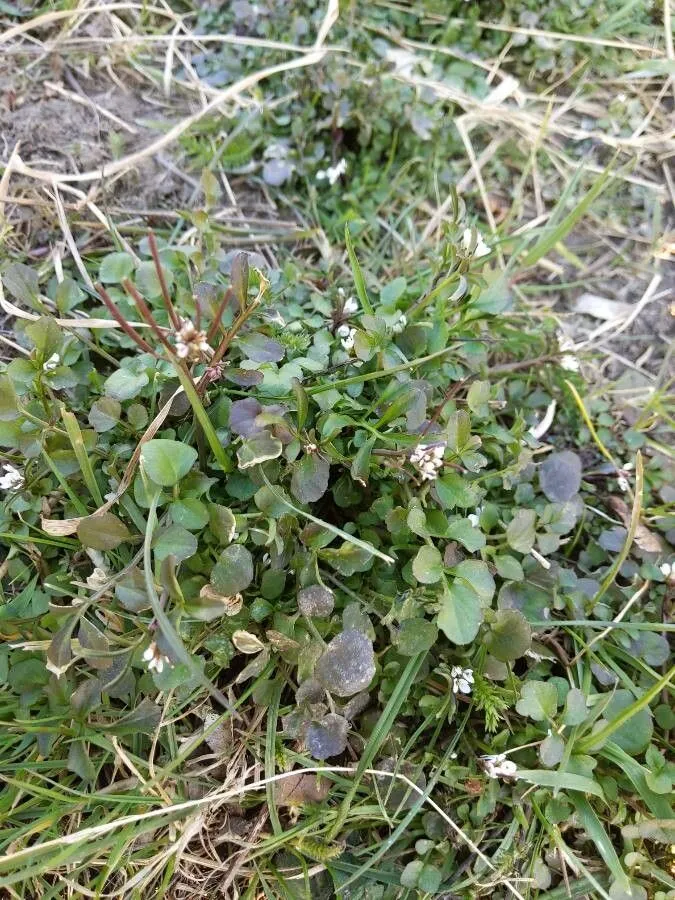
Author: L.
Bibliography: Syst. Nat. ed. 10, 2: 1131 (1759)
Year: 1759
Status: accepted
Rank: species
Genus: Cardamine
Vegetable: False
Observations: Temp. Eurasia, Subarctic America to N., C. & E. U.S.A.
Sand bittercress, known scientifically as Cardamine parviflora, is a delicate but resilient member of the Brassicaceae family. This unassuming plant has managed to carve out a niche for itself across various regions, from temperate areas of Eurasia to the subarctic regions of North America. Its presence also spans the central and eastern United States, highlighting its adaptability to a variety of climates.
First documented in the 10th edition of “Systema Naturae” in 1759, and attributed to the renowned botanist Carl Linnaeus (often abbreviated as L.), Sand bittercress has been a subject of interest for botanists for centuries. The plant’s historical documentation underscores its longstanding significance in botanical studies.
Cardamine parviflora thrives in specific environmental conditions that include temperate and subarctic zones. These regions provide the necessary climate for its growth and propagation. Despite its modest appearance, Sand bittercress has a subtle beauty enhanced by its small, white blooms which appear during its flowering season. These tiny flowers are indicative of its genus, noted for their characteristic four-petaled structure.
The plant is not just an interesting specimen for botanists but also holds ecological value. It contributes to the biodiversity of the ecosystems it inhabits, offering a host of benefits to local wildlife and maintaining soil health in its growth areas.
Studying Sand bittercress provides insight into the survival strategies of plants in varied climates and promotes a greater understanding of botanical diversity within the Brassicaceae family. Its wide geographical distribution is a testament to its adaptability and evolutionary success.
Deu: kleinblütiges schaumkraut
Eng: sand bittercress, small-flowered bittercress, small bittercress
Nob: damkarse
Nno: damkarse
Swe: rantalitukka, strandbräsma
Fin: rantalitukka
Fra: cardamine à petites fleurs, cardamine des sables, cardamine parviflore
En: Sand bittercress, Small-flowered bittercress, Small bittercress, Small-flower Bittercress, Small-flowered bitter-cress, Smallflowered bittercress
Bg: Дребноцветна горва
Zh: 小花碎米荠
Cs: Řeřišnice malokvětá
Eo: Kardamino etflora
Fi: Rantalitukka
Fr: Cardamine à petites fleurs, Cardamine des sables, Cardamine parviflore, Cardamine flexueuse, Cardamine des bois, Cardamine hérissée, Cresson de muraille, Cardamine impatiens, Cardamine impatiente, Herbe au diable
De: Kleinblütiges Schaumkraut
Hu: Kisvirágú kakukktorma
It: Billeri a fiori piccoli
No: Damkarse
Nb: Damkarse
Nn: Damkarse
Pl: Rzeżucha drobnokwiatowa
Ru: Сердечник мелкоцветковый
Sv: Strandbräsma, Rantalitukka
Zh-tw: 小花碎米薺
Zh-hant: 小花碎米薺
Taken Mar 24, 2021 by Mathieu VALENTIN (cc-by-sa)
Taken Mar 10, 2022 by cscoq (cc-by-sa)
Taken Mar 24, 2021 by Mathieu VALENTIN (cc-by-sa)
Taken Apr 8, 2018 by Laurent Ledante (cc-by-sa)
Taken Mar 24, 2021 by Mathieu VALENTIN (cc-by-sa)
Taken Feb 5, 2020 by Marjorie Dewaele (cc-by-sa)
Taken May 5, 2022 by Roberto d’Amore (cc-by-sa)
Taken Apr 11, 2020 by Kleiner Prinz (cc-by-sa)
Taken Apr 13, 2020 by Muriel SICARD (cc-by-sa)
Taken Mar 10, 2022 by cscoq (cc-by-sa)
Taken Apr 25, 2021 by Guillaume MOULIN (cc-by-sa)
Taken May 3, 2019 by Jingge Yan (cc-by-sa)
Taken Feb 21, 2020 by Pedro Neves (cc-by-sa)
Taken Mar 24, 2021 by Mathieu VALENTIN (cc-by-sa)
Taken Mar 10, 2022 by cscoq (cc-by-sa)
Taken Apr 7, 2020 by Cyril Longuépée (cc-by-sa)
Taken Apr 5, 2020 by Ludovic GROSSHANS (cc-by-sa)
Taken Jan 14, 2021 by Pradip Oli (cc-by-sa)
Taken Apr 5, 2018 by Christine Gerlat (cc-by-sa)
Taken Mar 31, 2022 by Dieter Bausenwein (cc-by-sa)
Taken Aug 15, 2010 by Photoflora – Benoit BOCK (©)
Taken Jan 1, 1970 by Photoflora – L’Abbé COSTE (©)
Taken Apr 30, 1877 by Tela Botanica − Herbier PONTARLIER-MARICHAL (cc-by-sa)
Taken Jun 30, 1872 by Tela Botanica − Herbier PONTARLIER-MARICHAL (cc-by-sa)
Taken Jun 30, 1849 by Tela Botanica − Herbier PONTARLIER-MARICHAL (cc-by-sa)
Taken Apr 5, 2020 by Chris Georges (cc-by-sa)
Taken Mar 31, 2018 by ciriaco (cc-by-sa)
Taken May 28, 2020 by Onur Tikir (cc-by-sa)
Taken Apr 9, 2020 by Filippo (cc-by-sa)
Taken Feb 10, 2016 by EOL − Linda Jo Conn (cc-by-nc)
Growth habit>: Forb/herb
Ph maximum: 7.5
Ph minimum: 7.0
Light: 8
Atmospheric humidity: 8
Soil nutriments: 7
Family: Myrtaceae Author: (F.Muell.) K.D.Hill & L.A.S.Johnson Bibliography: Telopea 6: 402 (1995) Year: 1995 Status:…
Family: Rubiaceae Author: Pierre ex A.Froehner Bibliography: Notizbl. Bot. Gart. Berlin-Dahlem 1: 237 (1897) Year:…
Family: Sapindaceae Author: Koidz. Bibliography: J. Coll. Sci. Imp. Univ. Tokyo 32(1): 38 (1911) Year:…
Family: Asteraceae Author: A.Gray Bibliography: Pacif. Railr. Rep.: 107 (1857) Year: 1857 Status: accepted Rank:…
Family: Fabaceae Author: Medik. Bibliography: Vorles. Churpfälz. Phys.-Ökon. Ges. 2: 398 (1787) Year: 1787 Status:…
Family: Aspleniaceae Author: (Cav.) Alston Bibliography: Bull. Misc. Inform. Kew 1932: 309 (1932) Year: 1932…